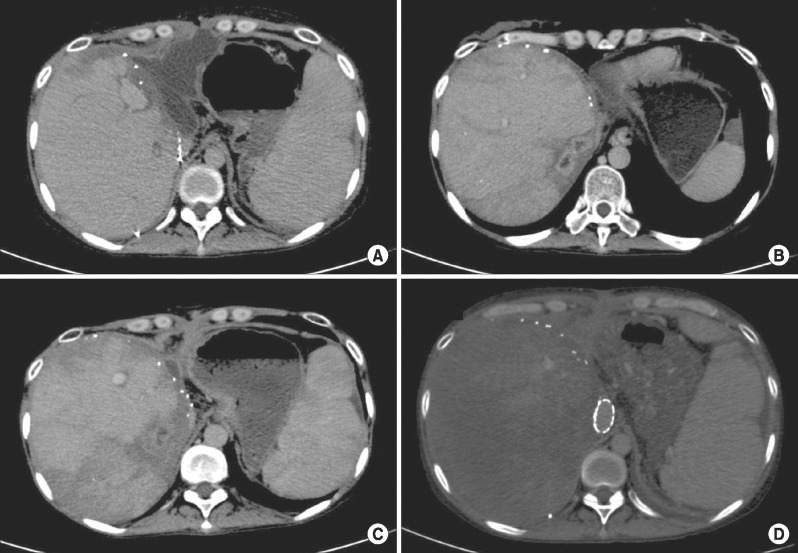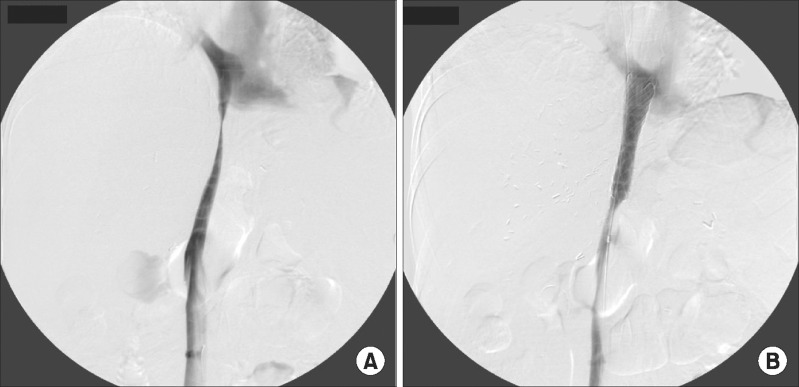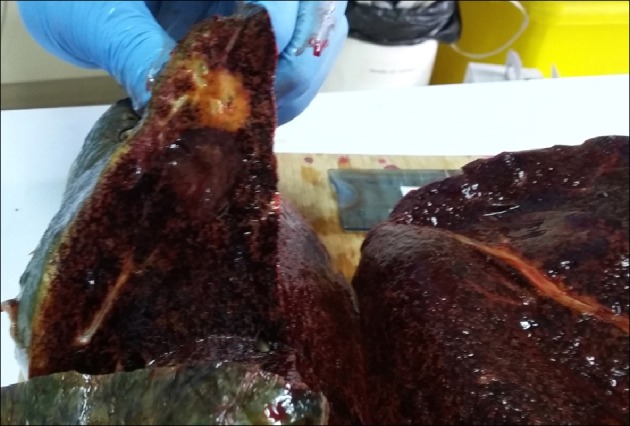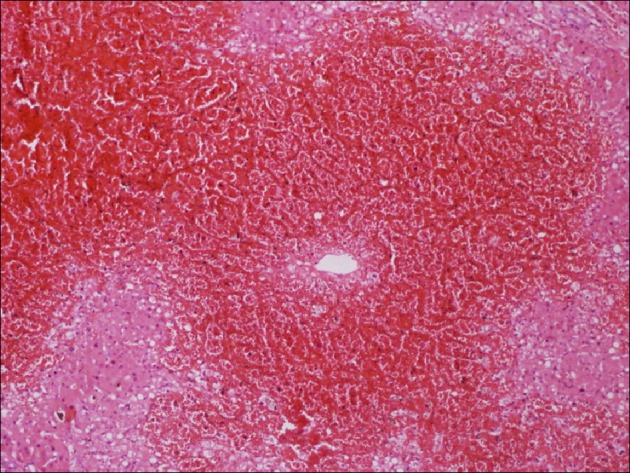Korean J Hepatobiliary Pancreat Surg.
2016 Aug;20(3):133-136. 10.14701/kjhbps.2016.20.3.133.
Inferior vena cava stenosis-induced sinusoidal obstructive syndrome after living donor liver transplantation
- Affiliations
-
- 1Department of Surgery, Mongolian National University of Medical Science, Ulaanbaatar, Mongolia. batsaikhan@mnums.edu.mn
- 2Department of General Surgery, First Central Hospital of Mongolia, Ulaanbaatar, Mongolia.
- KMID: 2351301
- DOI: http://doi.org/10.14701/kjhbps.2016.20.3.133
Abstract
- The sinusoidal obstructive syndrome (SOS) is a complication that usually follows hematopoietic stem cell transplantation. It is also known as veno-occlusive disease, which is a rare complication of living donor liver transplantation (LDLT). Herein, we reported a 34 year-old female patient presenting SOS after LDLT. Its underlying cause was presumed to be associated with liver abscess and subsequent inferior vena cava stenosis. SOS led to graft failure, thus requiring retransplantation with a deceased donor liver graft. The underlying causes of SOS are complex pathologic entity with multifactorial etiology. It is likely that its multifactorial etiology includes a decrease of hepatic venous outflow that is caused by graft liver infection and inferior vena cava stenosis.
Keyword
MeSH Terms
Figure
Reference
-
1. Bras G, Jelliffe DB, Stuart KL. Veno-occlusive disease of liver with nonportal type of cirrhosis, occurring in Jamaica. AMA Arch Pathol. 1954; 57:285–300. PMID: 13147641.2. Takamura H, Nakanuma S, Hayashi H, Tajima H, Kakinoki K, Kitahara M, et al. Severe veno-occlusive disease/sinusoidal obstruction syndrome after deceased-donor and living-donor liver transplantation. Transplant Proc. 2014; 46:3523–3535. PMID: 25498084.
Article3. Dulley FL, Kanfer EJ, Appelbaum FR, Amos D, Hill RS, Buckner CD, et al. Venocclusive disease of the liver after chemoradiotherapy and autologous bone marrow transplantation. Transplantation. 1987; 43:870–873. PMID: 3296355.4. Kumar S, DeLeve LD, Kamath PS, Tefferi A. Hepatic veno-occlusive disease (sinusoidal obstruction syndrome) after hematopoietic stem cell transplantation. Mayo Clin Proc. 2003; 78:589–598. PMID: 12744547.
Article5. Carreras E. Veno-occlusive disease of the liver after hemopoietic cell transplantation. Eur J Haematol. 2000; 64:281–291. PMID: 10863974.
Article6. Marín-Gómez LM, Álamo-Martínez JM, Suárez-Artacho G, Ramírez-Santos J, Bernal-Bellido C, Barrera-Pulido L, et al. Is the sinusoidal obstructive syndrome post-liver transplantation a pathologic entity with a multifactorial etiology? Rev Esp Enferm Dig. 2015; 107:235–238. PMID: 25824926.7. Dignan FL, Wynn RF, Hadzic N, Karani J, Quaglia A, Pagliuca A, et al. BCSH/BSBMT guideline: diagnosis and management of veno-occlusive disease (sinusoidal obstruction syndrome) following haematopoietic stem cell transplantation. Br J Haematol. 2013; 163:444–457. PMID: 24102514.
Article8. Tsirigotis PD, Resnick IB, Avni B, Grisariu S, Stepensky P, Or R, et al. Incidence and risk factors for moderate-to-severe veno-occlusive disease of the liver after allogeneic stem cell transplantation using a reduced intensity conditioning regimen. Bone Marrow Transplant. 2014; 49:1389–1392. PMID: 25068424.
Article9. Shen T, Feng XW, Geng L, Zheng SS. Reversible sinusoidal obstruction syndrome associated with tacrolimus following liver transplantation. World J Gastroenterol. 2015; 21:6422–6426. PMID: 26034381.
Article10. Rubbia-Brandt L. Sinusoidal obstruction syndrome. Clin Liver Dis. 2010; 14:651–668. PMID: 21055688.
Article11. Sebagh M, Debette M, Samuel D, Emile JF, Falissard B, Cailliez V, et al. "Silent" presentation of veno-occlusive disease after liver transplantation as part of the process of cellular rejection with endothelial predilection. Hepatology. 1999; 30:1144–1150. PMID: 10534334.
Article12. Sebagh M, Azoulay D, Roche B, Hoti E, Karam V, Teicher E, et al. Significance of isolated hepatic veno-occlusive disease/sinusoidal obstruction syndrome after liver transplantation. Liver Transpl. 2011; 17:798–808. PMID: 21351239.
Article13. Deleve LD. Dacarbazine toxicity in murine liver cells: a model of hepatic endothelial injury and glutathione defense. J Pharmacol Exp Ther. 1994; 268:1261–1270. PMID: 8138939.14. DeLeve LD, Wang X, Kuhlenkamp JF, Kaplowitz N. Toxicity of azathioprine and monocrotaline in murine sinusoidal endothelial cells and hepatocytes: the role of glutathione and relevance to hepatic venoocclusive disease. Hepatology. 1996; 23:589–599. PMID: 8617441.
Article15. DeLeve LD. Glutathione defense in non-parenchymal cells. Semin Liver Dis. 1998; 18:403–413. PMID: 9875557.
Article16. Daly AS, Hasegawa WS, Lipton JH, Messner HA, Kiss TL. Transplantation-associated thrombotic microangiopathy is associated with transplantation from unrelated donors, acute graft-versus-host disease and venoocclusive disease of the liver. Transfus Apher Sci. 2002; 27:3–12. PMID: 12201469.
Article
- Full Text Links
- Actions
-
Cited
- CITED
-
- Close
- Share
- Similar articles
-
- Late Hepatic Venous Outflow Obstruction Following Inferior Vena Cava Stenting in Patient with Deceased Donor Liver Transplantation Using Modified Piggyback Technique
- Inferior Vena Cava Stenosis Following Orthotopic Liver Transplantation: Differentiating Points from False Positives
- Quilt unification venoplasty of the right hepatic veins enabling double inferior vena cava anastomosis in living donor liver transplantation using a right liver graft
- Left at right heterotopic implantation of left liver graft in adult-to-adult living donor liver transplantation: the technical concern for decision-making
- Technical refinement of inferior vena cava replacement using a synthetic vascular graft in living donor liver transplantation





